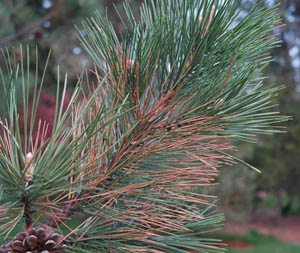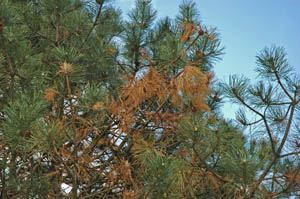Pine Disease Confusion | |
|---|---|
| May 6, 2008 | |
|
About this time of year, clients start to notice that their pines look less than perfect. Some of the chlorosis may be the result of wind burn. Salty mist from the road may account for one-sided chlorosis. Of greater concern are the necrotic stem tips, needles, or lesions on needles. Most symptoms present now are the result of infection last year. Work now to find out what caused the symptoms. Treatments for most pine diseases begin in the springónow. They work to protect the new growth as it emerges. If your pine looks like the image here, it most likely has one of the needle blight diseases (Dothistroma or brown spot).  Of course it is a good idea to have this verified by someone who can see the fungal pathogen in or on needles. The Plant Clinic is a good place to seek such help. Refer to issue no.1 for details about the Plant Clinic. Often the disease works from the bottom of the tree and moves upward. The newest needles are affected least, but you see some brown spots on them as well as the season progresses. The image of the branch tip shows that older needles have more lesions. Of course it is a good idea to have this verified by someone who can see the fungal pathogen in or on needles. The Plant Clinic is a good place to seek such help. Refer to issue no.1 for details about the Plant Clinic. Often the disease works from the bottom of the tree and moves upward. The newest needles are affected least, but you see some brown spots on them as well as the season progresses. The image of the branch tip shows that older needles have more lesions.  Dothistroma blight is discussed with other needle blights of pine in the Illinois Report on Plant Disease available at http://www.ag.uiuc.edu/~vista/abstracts/a624.html. Dothistroma blight is discussed with other needle blights of pine in the Illinois Report on Plant Disease available at http://www.ag.uiuc.edu/~vista/abstracts/a624.html. If the dead tissue on your pine is at the tips of branches, as seen in the image below, then it is more likely that Diplodia blight is the cause of decline.  This disease causes tips of branches to decline and often causes sappy exudate on branches, an indication of the canker phase of the disease. Entire limbs may die when Diplodia cankers girdle (strangle) the stems. You can link to more detailed information about Diplodia (Sphaeropsis) blight in the Illinois disease report at http://www.ag.uiuc.edu/~vista/abstracts/aSPHAERO.HTML. This disease causes tips of branches to decline and often causes sappy exudate on branches, an indication of the canker phase of the disease. Entire limbs may die when Diplodia cankers girdle (strangle) the stems. You can link to more detailed information about Diplodia (Sphaeropsis) blight in the Illinois disease report at http://www.ag.uiuc.edu/~vista/abstracts/aSPHAERO.HTML. Copper and mancozeb fungicides are used to protect new growth from infection with Dothistroma blight. A few more products are registered (chlorothalonil, myclobutanil, thiophanate-methyl, and fenarimol) for brown spot. Trade names of products and mobility of the products can be found in the Illinois Commercial Landscape and Turfgrass Pest Management Handbook. If Diplodia is the disease of concern, much more emphasis is placed on reducing tree stress through mulching and watering. In addition, removal of dead stems is helpful. Chemical options are available but are often too late once symptoms are visible. | |
| Author: | Nancy Pataky |
